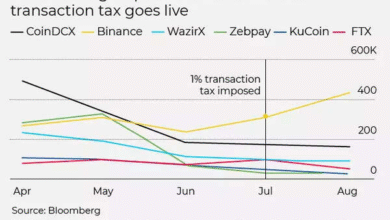Bitcoin Hashrate Peak Reaches New Heights Amid Price Surge

Bitcoin hashrate peak has reached astonishing new heights, recently soaring to a record 929 exahash per second (EH/s) as miners eagerly capitalize on the momentum generated by a price surge. This milestone not only signals intense competition among miners but also highlights a significant trend in Bitcoin mining, reflecting a steady growth in hashrate and operational efficiency. As the Bitcoin price surged, miners have started to see wider profit margins, a welcome change from the tighter margins they experienced in earlier weeks. Additionally, the decrease in mining difficulty has contributed to a favorable environment for miners, enabling them to find blocks more promptly and effectively. This combination of factors indicates that the cryptocurrency mining landscape is evolving rapidly, driven by innovation and a robust demand for Bitcoin.
The recent surge in Bitcoin’s computational power, also known as the hashrate, has captured the attention of the cryptocurrency community and investors alike. This surge represents not just the technical capabilities of Bitcoin mining operations but also signifies the increasing difficulty in validating transactions as miners compete fiercely for rewards. With the recent price upturn, a noticeable uptick in mining efficiency is evident, leading to a thriving marketplace for hashing power. Furthermore, the dynamics of the Bitcoin network are being reshaped by the constant fluctuations in mining difficulty and the adaptations that miners undertake to enhance their earning potential. The landscape of cryptocurrency mining is undoubtedly entering a period of heightened competition and technological advancement, setting the stage for future developments.
Understanding Bitcoin’s Hashrate Peak
Bitcoin’s hashrate peak, achieved at 929 exahash per second (EH/s), is a significant milestone that reflects the health and competitiveness of the Bitcoin mining ecosystem. This unprecedented growth indicates that miners are increasingly investing in advanced hardware and optimizing their operations to capitalize on the rising Bitcoin prices. The hashrate is a critical measure of the network’s security and stability, as higher hashrate correlates with a more robust defense against potential attacks. As Bitcoin experiences a price surge, the incentives for miners to increase their operational capacity also rise, fostering a dynamic environment where innovation is key.
Moreover, reaching the 929 EH/s peak suggests a broader trend of hashrate growth that could redefine future mining strategies. This spike serves as a signal for both new and existing miners to enhance their infrastructure in anticipation of ongoing price volatility. In the highly competitive landscape of cryptocurrency mining, those who adapt quickly to technological advancements are more likely to thrive. Understanding the significance of this hashrate peak is essential for anyone interested in the cryptocurrency market, as it underscores the interplay between mining difficulty, equipment optimization, and the price of Bitcoin.
The Impact of Bitcoin Price Surge on Mining Operations
The recent surge in Bitcoin’s price directly influences mining operations, leading to increased profitability for miners. The hashprice, which estimates the earnings from mining based on current hashrate and Bitcoin prices, jumped significantly, demonstrating that miners are enjoying healthier profit margins. Specifically, the hashprice rose 37.83%, from $40.04 to $55.18 per petahash per second (PH/s), indicating that the economics of mining are becoming more favorable. This profitability is essential for miners as they need to cover costs related to electricity, hardware maintenance, and operational efficiency.
As Bitcoin’s price continues to fluctuate, miners must remain agile and responsive to market conditions. The current price surge not only enhances daily revenues but also encourages miners to invest in more efficient mining equipment. This ongoing improvement can lead to advancements in the technology utilized within the mining sector, driving further increases in hashrate and sustainability. Consequently, understanding the relationship between Bitcoin price movements and mining operations is critical for investors, miners, and analysts alike.
Mining Difficulty Adjustments and Their Implications
The recent adjustments in Bitcoin’s mining difficulty play a pivotal role in shaping the mining landscape. On May 3, 2025, mining difficulty decreased by 3.34%, which allowed miners to discover blocks more effectively, dropping the average block time to 9 minutes and 33 seconds. Such a decrease in mining difficulty can alleviate some pressure on miners during times of increased competition and fluctuating Bitcoin prices. When mining difficulty adjusts favorably, especially during periods of rapid hashrate growth, it can lead to a more balanced and rewarding mining environment.
However, these adjustments are not just about easing competition; they also imply that miners should prepare for future shifts. The upcoming difficulty adjustment set for May 17, 2025, could bring changes that further influence the hashrate and miner profits. If mining continues at its current pace, this could lead to another increase in difficulty, creating a cycle of evolution within the mining sector. Understanding these dynamics is crucial for optimizing mining strategies and anticipating market trends that could affect profitability and operational viability.
Future Trends in Bitcoin Mining Technology
As Bitcoin mining evolves, technological advancements will play a crucial role in shaping the future landscape. The intense competition driven by rising hashrates and Bitcoin prices indicates that miners will increasingly seek out cutting-edge technologies to maintain their competitive edge. Innovations in hardware, such as the latest ASIC miners, promise to improve efficiency and reduce energy consumption. This shift not only makes mining more feasible but also addresses environmental concerns associated with high energy usage in cryptocurrency mining.
In addition to hardware improvements, software solutions are becoming more sophisticated, as miners leverage data analytics and AI for optimal performance. Enhanced monitoring systems and predictive analytics will enable miners to adjust their strategies in real-time, ensuring they operate at peak efficiency even as market conditions fluctuate. The future of Bitcoin mining is likely to be characterized by a blend of advanced technology and strategic planning, where success will hinge on the ability to innovate and adapt to an ever-changing landscape.
The Role of Competition Among Miners
Competition in Bitcoin mining is intensifying as miners vie for dominance in an ecosystem that is increasingly lucrative due to rising Bitcoin prices. With the hashrate hitting new peaks, miners are not only competing with one another for block rewards but are also in a race against time to deploy more efficient mining equipment. This competitive pressure drives operational excellence, encouraging miners to continuously improve their techniques and strategies.
Additionally, the competition among mining pools leads to technological collaboration and resource sharing, as smaller miners band together to optimize their computing power. As the mining landscape becomes more competitive, those who can forge strategic alliances and engage in collective bargaining for hardware purchases may find themselves better positioned to thrive. The dynamics of this competition will significantly influence the future of cryptocurrency mining and its overall impact on the Bitcoin network.
Assessing Mining Profitability in Today’s Market
Mining profitability remains a crucial consideration for miners, especially amid the ever-changing Bitcoin price landscape. With the recent increase in Bitcoin’s price and the corresponding surge in hashrate, many miners have seen a resurgence in their earnings, which is a welcome relief after previous lean periods. This resurgence allows miners to not only recover their costs but also invest in upgrading equipment and optimizing processes, which in turn can lead to even greater profitability.
However, potential miners must conduct thorough analyses of their operational costs, including electricity prices and hardware expenses, to accurately assess profitability. With the imminent possibility of further mining difficulty adjustments, understanding how these factors interplay is essential. By continuously monitoring market conditions and adapting to changes, miners can make informed decisions that safeguard their investments and enhance their profitability.
Navigating Regulatory Challenges in Cryptocurrency Mining
As the cryptocurrency market grows, so does the scrutiny from regulatory bodies worldwide. Miners must navigate an evolving landscape of regulations that aim to govern their activities, impacting everything from energy consumption to taxation. These regulatory challenges can significantly affect mining operations, as compliance may require changes in technology and processes, potentially impacting profitability.
Moreover, being proactive about regulatory compliance can present opportunities for miners. Those who adapt to regulations early on may find themselves at an advantage in the market, gaining trust with investors and stakeholders. As such, understanding the regulatory environment is essential not only for sustainability but also for ensuring long-term success in the dynamic field of cryptocurrency mining.
The Future of Mining Pools in Bitcoin Mining
Mining pools have become an essential aspect of Bitcoin mining, allowing individual miners to combine their resources and share the rewards of successful block discoveries. This collaborative approach enhances the chances of consistent payouts while reducing the financial risks associated with the volatile nature of Bitcoin mining. As competition intensifies, the significance of mining pools is likely to grow, becoming an integral element for both small and large miners alike.
In the future, we may see the emergence of more specialized mining pools that focus on specific cryptocurrencies or operational strategies. This diversification could lead to better optimization techniques and more tailored approaches to mining, ultimately boosting overall efficiency. As the mining landscape continues to evolve, participating in the right pool and leveraging collective resources could play a pivotal role in determining a miner’s success.
The Importance of Energy Efficiency in Bitcoin Mining
Energy efficiency has become a vital consideration in Bitcoin mining due to rising operational costs and increasing awareness of environmental impacts. Miners are now prioritizing energy-efficient technologies and sustainable practices to not only drive down their costs but also to align with global sustainability initiatives. As energy resources become scarcer and more expensive, optimizing energy consumption will likely be essential for maintaining profitability in the long run.
Innovative solutions, such as utilizing renewable energy sources and implementing more efficient cooling systems, will play a critical role in the future of Bitcoin mining. As miners adopt these practices, they will not only contribute positively to the environment but also enhance their reputational standing in the industry. It is essential for miners to stay ahead of the curve by embracing energy-efficient technologies, which will ultimately dictate their ability to thrive in an increasingly competitive landscape.
Frequently Asked Questions
What does the Bitcoin hashrate peak indicate for Bitcoin mining?
The Bitcoin hashrate peak, which recently hit a record 929 exahash per second (EH/s), indicates heightened competition in Bitcoin mining. This surge reflects the increasing investment in mining infrastructure and the race among miners to secure block rewards as Bitcoin prices rise.
How does the increase in Bitcoin hashrate affect mining difficulty?
Typically, an increase in Bitcoin hashrate leads to a rise in mining difficulty to maintain block generation times at approximately 10 minutes. With the recent hashrate peak, we might see future adjustments that could further challenge miners to enhance their equipment and efficiency.
What are the implications of the Bitcoin price surge on hashrate growth?
The Bitcoin price surge directly contributes to hashrate growth as higher prices improve mining profitability. Miners are incentivized to increase their computational power to capitalize on greater earnings, driving the hashrate to new peaks like the recent 929 EH/s.
How does Bitcoin hashrate peak influence the hashprice for miners?
As the Bitcoin hashrate peaks, like it did recently, the hashprice—the value of one petahash per second—can rise, reflecting increased demand for mining power. This recent hashrate growth saw the hashprice soar by over 37%, offering miners improved profit margins during this price surge.
What does a decreasing mining difficulty mean for Bitcoin miners?
A decrease in mining difficulty, such as the recent 3.34% drop, means that miners require less computational effort to discover new blocks. This allows for quicker block discovery times, enhancing overall mining efficiency and profitability during periods of soaring hashrate.
What future trends can we expect from the recent Bitcoin hashrate peak?
The recent Bitcoin hashrate peak may signal an era of intensified competition and innovation among mining pools. As miners adjust to the new mining difficulty and seek improved operational strategies, we can anticipate advancements in mining technology and possible consolidation in the industry.
Why is monitoring Bitcoin hashrate peak important for investors?
Monitoring Bitcoin hashrate peaks is essential for investors as it serves as an indicator of miner sentiment and network security. A high hashrate typically reflects a robust network, potentially leading to increased confidence in Bitcoin’s stability and future pricing.
How does the competition among miners affect Bitcoin’s network security?
Intense competition among miners, as evidenced by new hashrate peaks, enhances Bitcoin’s network security. More computational power devoted to the network makes it more resistant to attacks, thereby strengthening the overall integrity of the Bitcoin ecosystem.
| Key Point | Details |
|---|---|
| Hashrate Peak | Bitcoin’s hashrate reaches a new record of 929 EH/s. |
| Previous Peak | Previous hashrate peak was 926 EH/s on April 8, 2025. |
| Mining Profitability | Miners are benefiting from higher bitcoin prices, leading to increased profit margins. |
| Hashprice Increase | Hashprice jumped 37.83% from $40.04 to $55.18 per PH/s. |
| Mining Difficulty Adjustment | Mining difficulty decreased by 3.34% on May 3, 2025. |
| Block Discovery Rate | Blocks are currently being found in an average of 9 minutes and 33 seconds. |
| Future Projections | Potential for a new difficulty adjustment on May 17, 2025, based on current pace. |
| Competitive Landscape | Increased hashpower may lead to new investments and technological advancements in mining. |
Summary
The Bitcoin hashrate peak signifies a pivotal moment in the cryptocurrency’s evolution, especially as it reaches a historic 929 EH/s. This surge, driven by rising bitcoin prices and mining profitability, indicates strong competition among miners. With the possibility of changes in mining difficulty scheduled for mid-May 2025, the landscape of bitcoin mining is set for further innovation and potential growth, positioning miners for an exciting new chapter in securing and reinforcing the blockchain network.




